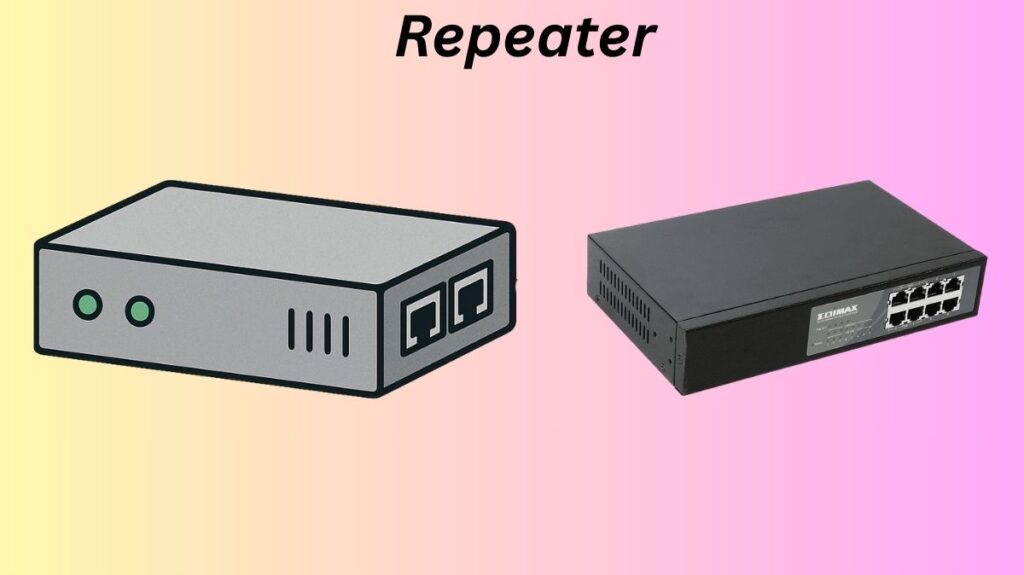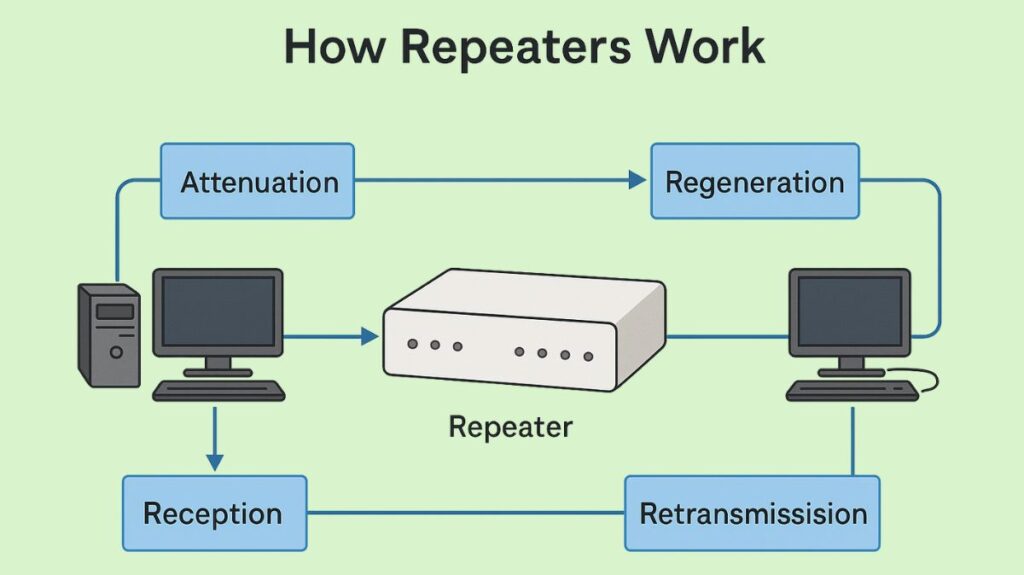Repeater in Networking

According to the OSI reference model, a repeater is an electrical networking device that mostly functions at Layer 1, or the physical layer. Its primary function is to retime and regenerate network signals at the bit level so that they can navigate a networking media over greater distances. Another name for them is signal enhancers.
How Repeaters Work in Networking

- The farther a network signal goes from its source across a cable, the weaker it becomes. Refer to this weakening as attenuation.
- The attenuated signal is sent to a repeater.
- The signal is then restored to its initial intensity and quality through regeneration.
- The amplified signal is then retransmitted by the repeater.
Why are Repeaters needed?
Depending on the technology or the characteristics of the channel, an electrical signal is attenuated during transmission. This places restrictions on the cellular networks’ coverage region or LAN’s length. Repeater in Networking are installed at specific intervals to mitigate this issue.
Repeaters retransmit the attenuated signal after amplifying it. Even signals that have been distorted by transmission loss can be restored by digital repeaters. Repeaters are therefore frequently used to link two LANs together to create a single, big LAN.
Advantages of Repeater in Networking
Repeater in Networking are necessary to improve network performance and get around restrictions caused by distance. Among their main goals and benefits are:
Extending Network Range: They make it possible to increase the network’s range beyond the actual bounds of a single cable segment, such the 100-meter restriction for UTP cable.
Improving Signal Integrity: Repeaters guarantee that data reaches its destination with sufficient strength and fewer mistakes by renewing signals.
Connecting Different Network Segments: Repeaters can create a bigger unified LAN by connecting different network segments, particularly when they are too far away for direct connectivity.
Cost-effectiveness: In general, repeaters are less costly than other network equipment.
Fault Tolerance: They can isolate breakdowns to certain cable segments, adding fault tolerance.
Media Support: Networks may be connected utilizing a variety of physical media sources with repeaters’ ability to connect several kinds of cables.
Reduced Processing Time: Sometimes they take less time to process.
Overcoming Physical Barriers: Physical obstacles that might weaken wireless signals can be lessened with the usage of wireless repeaters.
Relationship with Hubs
At its core, a hub is a multiple-port repeater. Whereas a hub usually has many more ports (four to twenty or more), a classic repeater may only have two. Hubs and repeaters both function at Layer 1 of the OSI model; they neither analyze any data (MAC addresses, for example) nor rely their forwarding choices on information from higher layers. A packet is copied to all of the other open ports on a hub or repeater when it reaches one of its ports. One important difference is that hubs only broadcast incoming data to all connected devices, whereas repeaters recycle the signal.
Types of Repeater in Networking
Repeater in Networking can be categorized according to a number of factors:
According to the Type of Signals
- Only analogue transmissions are amplified using analogue repeaters. After receiving and amplifying the analogue signal, analogue repeaters reproduce it as the output. In earlier network systems that employed analogue signals, analogue Repeater in Networking were mostly utilized.
- Digital Repeater: Digital repeaters are the kind of repeaters that directly reproduce digital signals rather than amplifying them. The majority of current technology that employ digital signals use digital repeaters. Rebuilding a distorted signal is another capability of digital repeaters.
According to the Type of Connected Network
Wired Repeaters: In wired Local Area Networks (LANs), wired repeaters are utilized. The signal is received by a wired repeater, which then repeats it. This keeps the network’s strength and data intact while extending its journey data.
Wireless Repeaters: Cellular networks and wireless local area networks (LANs) both employ wireless repeaters. The repeater receives a wireless signal from a router that is linked to the network. Once received, the signal is relayed via a repeater to expand the network’s reach.
According to the Domain of LAN Networks
Local Repeaters: In local area networks, which are extremely small networks, local repeaters are employed. The gadgets linked to the network are fairly close to one another.
Remote Repeaters: In large-scale local area networks, remote repeaters are utilized. There is a greater distance between the networked devices.
Based on Technologies
Telephone Repeater: A radio repeater is a radio receiver and transmitter that retransmits a radio signal; an optical repeater is an optoelectronic circuit that amplifies the light beam in an optical fiber cable; and a telephone repeater is an amplifier in a telephone line.
Optical Communications Repeater: A particular kind of repeater used for fiber optic communication systems is known as an optical repeater. Prior to transmission, the processes can be amplified and reshaped using optical repeaters. All of the signals from the optical fiber cable are captured by the optical repeater and converted to electronic format.
Radio Repeater: Increases a radio signal’s coverage range; it usually consists of a transmitter and receiver that retransmit the signal, frequently on a different frequency. Cellular repeaters, amateur radio repeaters, microwave relays, and broadcast relay stations are a few examples.
Microwave Repeater: Microwave repeaters are a particular kind of repeater that is positioned between the transmitting and receiving stations, or source and destination. The distance between two devices determines whether to utilize a microwave repeater. High power transmitters and sensitive receivers are employed in microwave repeaters.
Digipeater: A packet radio network’s repeater node. It transfers information packets from one node to another by carrying out a store and forward operation.
Additionally, repeaters are categorised as Class I (up to 140 bit-times) or Class II (up to 92 bit-times) depending on the delay they add.
Disadvantages of Repeater in Networking
Repeaters have a number of drawbacks despite their benefits:
Enlarged Collision Domains: All linked devices are in the same collision and broadcast domain with repeaters and hubs, which extend collision domains. This makes collision issues worse on shared-medium LANs, which results in lower overall bandwidth (e.g., 10 Mbps for hubs).
No Traffic Management: They are unable to mitigate the effects of network traffic and congestion since they do not partition networks or control traffic flow.
Limited Number of Repeaters: The maximum number of repeaters that may be installed is restricted in the majority of networks. For 10 Mbps bus-based Ethernet, breaking the “Four Repeater Rule” (also known as the 5-4-3 Rule) might result in more late collisions and worse network performance because of latency and propagation delay.
Cannot Connect Dissimilar Networks: Repeaters cannot connect networks with dissimilar designs; gateways or routers must.
Cannot Differentiate Signal from Noise: Repeaters cannot distinguish noise from signal.
Bandwidth Usage: Because the channel is busy twice as long, wireless repeaters that use a single transmitter and receiver can cut throughput in half. In order to counteract this, some wireless repeaters use two transmitters and receivers on separate channels.
